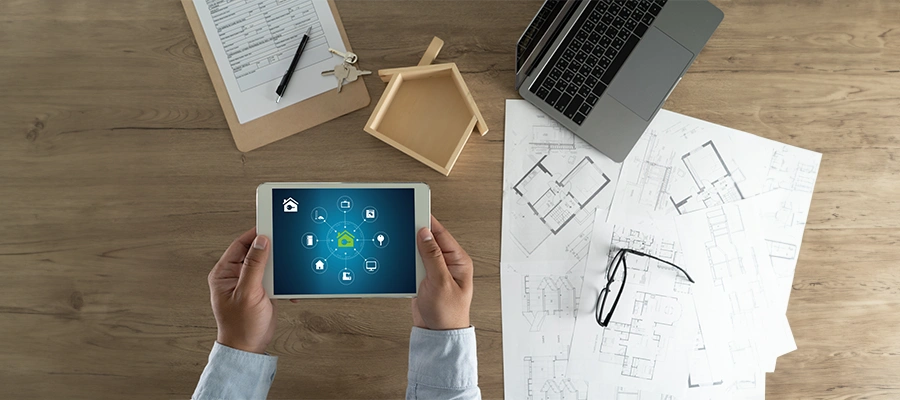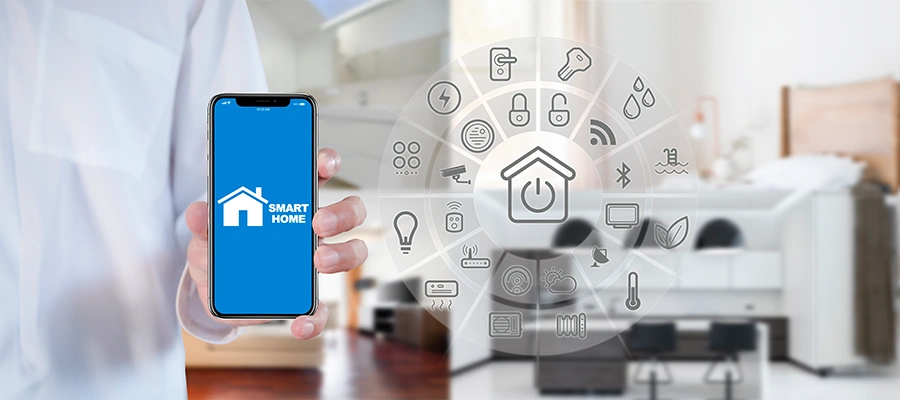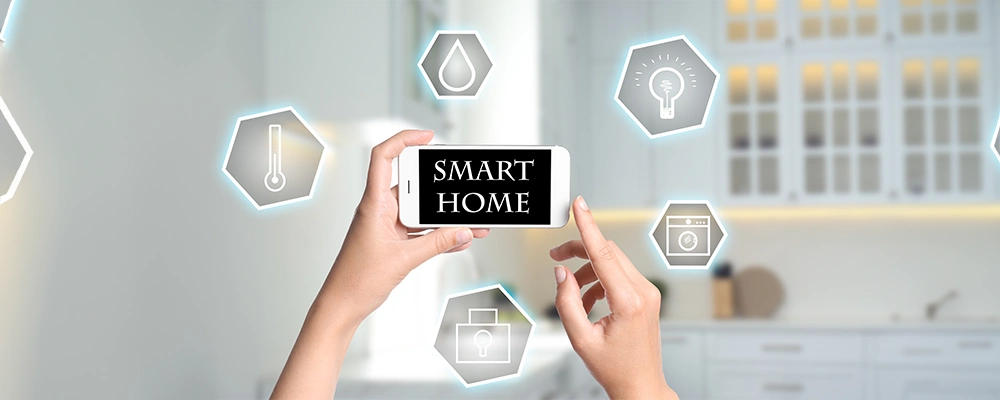A new age in construction has begun with the incorporation of smart home technologies in the ever-evolving field of technology. Modern automation systems in smart homes are revolutionising how we use our living areas. Automation and smart homes are changing how we live by making our lives safer, more convenient, and more energy efficient. As home automation systems continue to grow, the smart house of the future is likely to be a community of gadgets that work together to improve life and change how people think about homes. The houses we construct now are at the vanguard of this revolutionary shift toward a more innovative, more connected future, which has already started. For your basic understanding, Brick & Bolt brings all the trends in home automation using smart home technology.
- 1 The Integration of Smart Home Technologies in Construction
- 2 Trends in Home Automation:
- 2.1 Intelligent Security Systems:
- 2.2 Energy Management Solutions:
- 2.3 Voice-Activated Assistants:
- 2.4 Smart Appliances:
- 2.5 Automated Window Treatments:
- 2.6 The Rise of the Connected Home:
- 2.7 Security Beyond Traditional Measures:
- 2.8 Energy-Efficient Living:
- 2.9 Voice-Activated Convenience:
- 2.10 Customised Home Entertainment:
The Integration of Smart Home Technologies in Construction

The idea behind smart homes is to combine different technologies to improve the security, energy efficiency, and comfort of living areas. As technology advances, the construction sector has completely embraced smart home devices. Infrastructure facilitating smooth communication and automation is incorporated during these integration planning and design phases.
Smart Infrastructure:
Establishing a solid infrastructure to facilitate automation is the first step in creating a smart home. This covers integrated control panels, smart electrical systems, and high-speed internet access. These days, builders include these components in the design process to ensure houses are ready for the newest innovative technology.
Wireless Connectivity:
The widespread use of wireless technology has changed how smart homes are designed and built. With Bluetooth and Wi-Fi, devices, sensors, and smart products can now easily talk to each other, creating an ecosystem inside the home that works together. Many of the features found in smart homes depend on this wireless communication.
Trends in Home Automation:

Intelligent Security Systems:
Automation has made home security more intelligent and advanced. Homeowners can monitor and manage their security systems in real-time with smart locks, facial recognition, doorbells, and surveillance cameras. When their mobile apps are integrated, users can remotely control entry to their houses and receive fast alerts.
Energy Management Solutions:
As environmental awareness grows, energy control is becoming a big trend in smart homes. Intelligent lighting systems, energy-efficient equipment, and automatic thermostats can help homeowners get the most out of their energy use. Automatic computer programs called machine learning algorithms look at patterns in how much energy is used and give suggestions for making things even more efficient.
Voice-Activated Assistants:
Virtual assistants that you can talk to, like Google Assistant and Amazon’s Alexa, are already important parts of smart houses. Because these assistants are driven by AI, users can control different home functions with their voices, like playing music, locking doors, and changing the temperature.
Smart Appliances:
The kitchen and laundry room are now automated due to the introduction of smart appliances. Smart washing machines, dishwashers, stoves, and refrigerators can all be operated from a distance. With the help of smart equipment, the kitchen and laundry room are now fully automated. Smart fridges, stoves, dryers, and washing machines can all be controlled from afar. Some models may even recognise user habits to maximise efficiency and performance.
Automated Window Treatments:
Smart window treatments include motorised blinds and curtains that can be set to change based on temperature, sunlight strength, and time of day, among other things. This keeps the temperature inside stable, which is not only more convenient but also saves energy.
The Rise of the Connected Home:
A common way to tell a smart home apart is by how well its many systems and gadgets work together. In a networked home, for example, a central hub would let people control lighting, thermostats, entertainment systems, and security cams from a single screen. The ease and overall user experience are improved by this degree of integration.
Security Beyond Traditional Measures:
Smart homes come with cutting-edge security features that go beyond conventional methods. A complete security architecture is offered via facial recognition technology, biometrically accessible smart locks, and integrated alarm systems. These elements give homeowners peace of mind in addition to discouraging possible intruders.
Energy-Efficient Living:
By using intelligent systems, smart homes make energy efficiency a priority. Automatic thermostats adapt to the user’s temperature preferences, while intelligent lighting systems minimise energy use by varying colour temperature and brightness. Remote monitoring and control of these devices allows homeowners to ensure that energy is used effectively even when not at home.
Voice-Activated Convenience:
In smart homes, voice-activated virtual assistants are the height of convenience. Homeowners can use voice commands to operate smart gadgets, play music, make reminders, and even get recent news headlines. In addition to being practical, this hands-free method of home administration also lends a hint of sophisticated futurism.
Customised Home Entertainment:
Smart homes are redefining the entertainment landscape. Modern audio and video systems installed in home theatres allow for the seamless integration of smart devices. Users can manage every aspect of the entertainment system with just one app or voice control, including volume adjustments and light dimming.
In summary, the rise of smart home technology is changing how we live by making it safer, more convenient, and more energy-efficient. The smart home devices try to make our lives safer and more comfortable, from control panels built into wifi connections. Voice-activated assistants, smart security systems, and energy management tools make daily chores easier and give you peace of mind. With entertainment choices that can be changed to fit our tastes and needs, smart homes are the way of the future for our living spaces. The houses we build today are setting the stage for a more connected and efficient future as this trend continues to grow.

